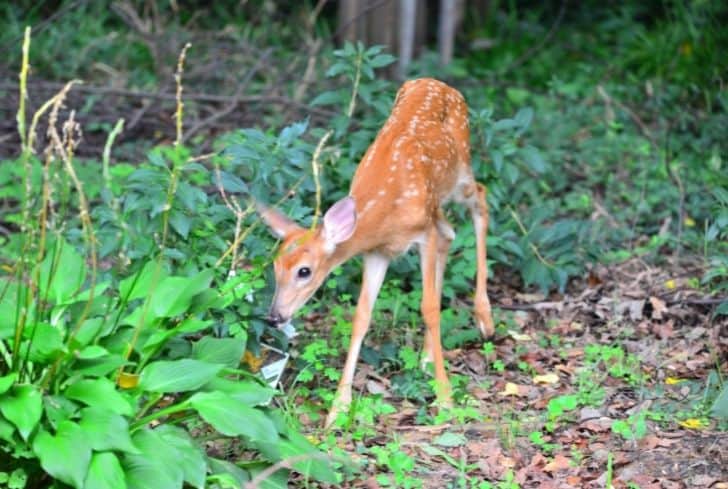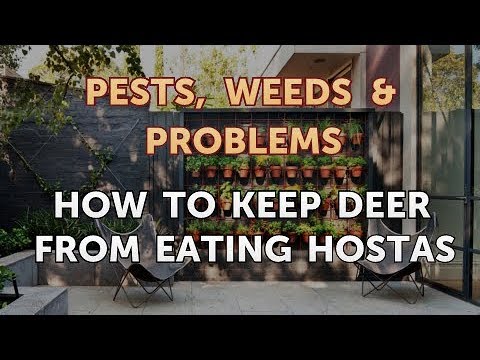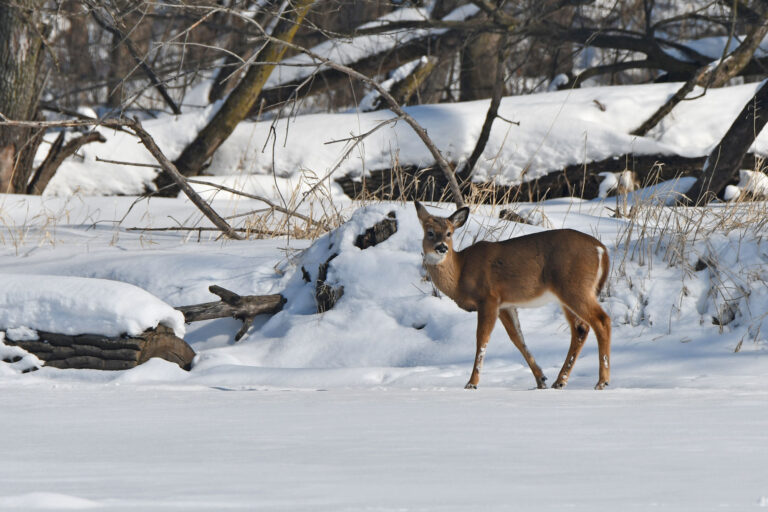How to Keep Deer from Eating Hostas
To deter deer from eating hostas, employ repellents or physical barriers. Install fencing or use homemade remedies like soap or pepper sprays.
Gardeners value hostas for their lush foliage and shade tolerance, making them a popular choice for landscaping. Unfortunately, these plants often fall prey to hungry deer, a common dilemma for those who strive to maintain a pristine garden. Keeping deer at bay requires a blend of ingenuity and strategy.
Opting for deer-resistant plants is one preventive approach, while others include the application of commercial repellents or DIY solutions that make hostas less appetizing to wildlife. Ensuring hostas thrive without becoming a free buffet for the local deer population can be achieved by integrating a variety of these tactics and regularly monitoring their effectiveness throughout the growing season.
Understanding Deer Behavior
Effective deer deterrence starts with understanding how these graceful creatures think and behave. Observing the feeding patterns of deer is instrumental in implementing strategies to protect your hostas. Deer are opportunistic feeders with preferences that shift with the seasons and available food sources. Recognizing when and how they may target your hostas is key to keeping these lush plants safe from their appetites.
Deer Feeding Habits
Deer are primarily crepuscular, meaning they are most active during dawn and dusk. During these times, they forage for food, often venturing into gardens that provide easy access to tasty treats like hostas. Understanding this pattern can inform the timing of deterrent measures. Moreover, deer exhibit strong food preferences, which, unfortunately for garden enthusiasts, include the tender leaves and shoots of hostas.
- Peak Feeding Times: Dawn and dusk.
- Preferred Food: Hostas, among other garden plants.
- Behavioral Pattern: Seasonal changes influence diet preference.
Identifying Deer Predation On Hostas
Knowing the signs of deer activity can help you take early action to protect your hostas. Look for:
- Jagged Edges: Deer leave ragged, torn edges on leaves they’ve browsed.
- Hoof Prints: These may appear around the garden, especially after rain.
- Droppings: Small, pellet-like deer droppings can often be found near feeding sites.
Natural Deterrents
Welcome to the natural world of deer deterrents where your beloved hostas can thrive without becoming an all-you-can-eat buffet. Protecting your hostas naturally is not only better for the environment, but it also keeps the garden eco-friendly and safe for all visitors, whether they are on two legs or four.
Planting Deer-Resistant Flowers and ShrubsPlanting Deer-resistant Flowers And Shrubs
Creating a barrier with foliage that deer generally avoid is one of the most effective strategies. These plants produce either a scent or a taste that deer find disagreeable. Incorporating such plants can offer a friendly solution to your deer problem.
- Daffodils: Toxic to deer, these vibrant flowers are often avoided.
- Marigolds: Their strong fragrance can deter deer.
- Lavender: Its potent scent is great for repelling deer and other critters.
- Boxwood: With its bitter taste, it’s rarely browsed by deer.
- Sage: Deer usually bypass sage due to its aromatic leaves.
By surrounding your hostas with these companion plants, you create a protective and attractive shield that is quite effective at keeping deer at bay.
Introducing Odor-Based RepellentsIntroducing Odor-based Repellents
Smells that offend the sensitive noses of deer can be an ideal way to safeguard your garden. When these repellents are properly applied, deer are likely to pass by without feasting on your plants.
| Repellent Type | Description | Frequency of Application |
|---|---|---|
| Egg-Based Sprays | Deer associate the smell of eggs with predators. | Re-apply after heavy rain. |
| Garlic Clips | Heavily scented, bothers deer’s sense of smell. | Every 2-3 months or as needed. |
| Soap Bars | Hanging soap bars can emit a fragrance that deer dislike. | Replace once the scent fades. |
While using odor-based repellents, it’s crucial to rotate them regularly to prevent deer from becoming accustomed to any one deterrent. Always read and follow the instructions on commercial repellents for optimal success.
Physical Barriers
Gardening enthusiasts know too well the frustration of spotting their lush hostas ravaged by deer. One effective strategy to protect these plants involves the use of physical deterrents. Erecting barriers creates an immediate and visible obstacle, discouraging deer from turning your prized hostas into their next meal. Read on to learn how to implement defensive measures that can blend seamlessly with your garden’s aesthetic while providing stout protection against four-legged intruders.
Installing Fencing Or Netting
Fencing is one of the most reliable physical barriers for keeping deer away from hostas. A fence needs to be high enough—typically 7 to 8 feet—to prevent deer from jumping over. For gardeners concerned about visual appeal, a variety of materials and styles are available that can enhance, rather than detract from, the look of a garden. Consider the following:
- Mesh Fencing: Nearly invisible from a distance, it provides an unobtrusive solution.
- Wooden Fences: Offer a classic aesthetic but may require a considerable budget.
- Metal Fences: Durable and often more decorative, perfect for a statement piece.
Netting offers a cost-effective and easy-to-install option. It can be draped over individual plants or used to create a perimeter barrier. For optimum effectiveness:
- Ensure it’s secured to the ground to prevent deer from pushing underneath.
- Use UV-resistant netting for long-term durability.
- Check periodically for gaps or tears and repair them promptly.
Implementing Scare Tactics
Another form of physical intervention involves scare tactics. These can range from simple to high-tech, with the common goal of startling deer enough to discourage them from approaching your hostas. Consider trifecta setups for a synergistic effect:
| Scare Tactic | How It Works | Efficiency |
|---|---|---|
| Motion-Activated Sprinklers | Sudden water burst upon motion detection | High |
| Reflective Tape | Flashes of light, especially at dusk and dawn | Moderate |
| Wind Chimes | Noise generated by wind movement | Variable |
Combining several methods may create a more startling effect and prove more successful. Rotation and variation of these tactics prevent deer from becoming accustomed to any one method, maintaining their effectiveness over time. Remember to install them at different heights and locations for the best results.
Home Remedies And Diy Solutions
Home Remedies and DIY Solutions often prove to be a sustainable and cost-effective method to protect your beloved hostas from deer. These solutions, crafted from everyday household items, can act as deterrents without causing harm to the wildlife or the environment. The relentless quest of deer for a leafy feast can be frustrating for gardeners, but with a few strategic practices and homemade concoctions, it’s possible to discourage these four-legged browsers.
Homemade Repellent Recipes
Deer have sensitive noses, which can be used to your advantage. The key is to concoct repellents that create an odor or taste that is unpleasant to them. Here are several mixtures you can create using ingredients often found in your pantry:
| Ingredient | Method | Application |
|---|---|---|
| Garlic and Eggs | Mix chopped garlic and a couple of eggs in water. Allow it to sit for a few days to intensify the scent. | Spray around your hostas, being careful not to apply directly to the plants. |
| Soap | Shave slivers of strongly-scented soap and scatter them around the plant beds. | The soap not only smells repulsive to deer but also can be unsavory if they attempt a nibble. |
| Hot Pepper | Boil hot peppers in water, let the mixture cool, and strain the liquid. | Apply the spicy solution around the garden periphery to give deer a fiery surprise. |
Gardening Practices To Deter Deer
Besides homemade mixes, certain gardening tactics can contribute significantly to keeping deer at bay. Consider these strategies:
- Strategic Planting: Plant pungent herbs like lavender, rosemary, or mint among your hostas; their intense scent often masks the appealing aroma of hostas.
- Physical Barriers: Erecting netting or tall fences can physically block deer from reaching your plants.
- Change in Texture: Introduce plants with fuzzy or prickly foliage nearby; these can be unappetizing to deer.
- Diverse Landscaping: Varied heights and densities in garden design can create a confusing environment for deer, making them less likely to venture in.
Professional Solutions
Gardening enthusiasts often face the challenge of protecting their beloved hostas from deer. While home remedies may provide temporary relief, those wanting to ensure the safety of their hostas might require more professional solutions. Commercial repellents and wildlife control agencies offer robust strategies for defending your green oasis. Let’s explore some of these professional-grade options to keep deer away from your hostas for good.
Commercial Deer Repellents
Commercial deer repellents are specifically formulated to deter deer through scent or taste aversion. These products are available in different forms, including sprays, granules, and systemic treatments. Here is how to select and apply commercial repellents:
- Check Active Ingredients: Look for repellents with natural ingredients like putrescent egg solids or capsaicin, which are safe for plants and the environment.
- Application Frequency: Follow the manufacturer’s instructions for application frequency, as weather conditions may necessitate more frequent applications.
- Coverage Area: Ensure the repellent covers the entire hosta plant. Some products may require application to surrounding soil.
- Rotating Products: Switch between different repellents periodically to prevent deer from becoming accustomed to a specific deterrent.
Seeking Assistance From Wildlife Control Agencies
Enlisting the services of wildlife control agencies is another viable option for those overwhelmed by deer invasions. These agencies provide professional evaluations and implement strategic measures tailored to your specific landscaping concerns. Below are the steps to seek help:
| Step | Action | Explanation |
|---|---|---|
| 1 | Consultation: | Schedule an onsite consultation for an expert to assess your property and the extent of deer activity. |
| 2 | Custom Plan: | Receive a customized plan that may include fencing, repellents, or habitat modifications to deter deer. |
| 3 | Implementation: | Professional implementation ensures the most effective and humane methods are used to protect your hostas. |
| 4 | Follow-Up: | Agencies often provide follow-up services to monitor the effectiveness and make adjustments as needed. |
Seeking professional solutions could be the key to maintaining the aesthetic and health of your garden without the worry of it becoming a deer’s next meal. By considering commercial repellents or engaging with wildlife control experts, you invest in long-term, effective strategies for deer-proofing your hostas.

Credit: www.conserve-energy-future.com
Frequently Asked Questions On How To Keep Deer From Eating Hostas
Why Do Deer Target Hostas In Gardens?
Deer are attracted to hostas due to their large, tender leaves, which provide a nutritious food source. Hostas often grow in accessible garden areas, making them an easy target for deer looking for a quick meal.
What Natural Remedies Deter Deer From Hostas?
Several natural remedies can deter deer, such as hanging soap bars, using human hair clippings, or applying homemade repellents with garlic, eggs, or pepper. Planting strongly-scented herbs like lavender or rosemary around hostas can also help.
Can Commercial Repellents Protect Hostas From Deer?
Yes, commercial repellents that contain ingredients like putrescent egg solids or capsaicin can effectively keep deer away from hostas. Apply repellents according to the manufacturer’s instructions for best results.
How Does Fencing Contribute To Deer-proofing Hostas?
Fencing can be very effective in deer-proofing your hostas. A fence height of at least 8 feet is recommended to prevent deer from jumping over. Ensure the fence is also buried several inches underground to deter digging.
Conclusion
Protecting your hostas from hungry deer can be a challenge, but with the right strategies, you can succeed. Employ a mix of deterrents like fencing, repellents, and companion planting to create an unappealing environment for deer. By staying vigilant and consistently applying these methods, your hostas can thrive in peace.
Enjoy the beauty of your garden without the worry of unwanted visitors.



